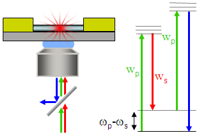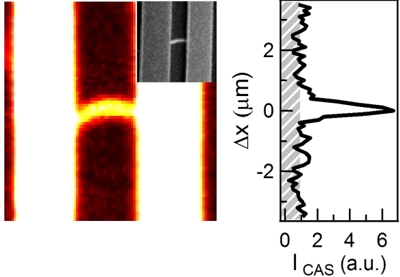 |
|
|
|
 |
|
|
 |

|
 |
 |
 |
 |
 |
 |
 |
Nonlinear Optics of Carbon Nanotubes |
Sharp optical resonances and strong antenna responses allows optical measurements to be performed on
individual SWNTs. Our research interest is to spectroscopically image SWNTs
with enough sensitivity to find and categorize individual defects.
Our strategy for enhancing sensitivity to defects is to use coherent, anti-Stokes Raman spectroscopy,
or CARS. CARS is a four-color technique that takes advantage of SWNTs' enhanced nonlinear response
at resonances. For example, by tuning to the strongest vibrational Raman resonance of
a SWNT (the "G-mode"), we can perform CARS imaging of the hexagonal carbon lattice with
extremely dark background fields.
When disorder and defects are present on a SWNT, the G-mode CARS signal disappears. In principle,
a new spectroscopic mode corresponding to C-H or C-O bonds takes its place. However, in practice we find
a strong coherent response of the SWNT carriers that produces an overlapping, electronic resonance.
By electrostatically gating this electronic response to zero, we continue trying to resolve
the chemical fingerprint of individual defects.
|
 |
|
|
 |
Publications |
Four-Wave Mixing Microscopy with Electronic Contrast of Individual Carbon Nanotubes
T. Sheps, J. Brocious, B.L. Corso, O.T. Gül, D. Whitmore, G. Durkaya, E.O. Potma & P.G. Collins
Phys. Rev. B 86, 235412 (2012).
Nonlinear Optical Imaging of Individual Carbon Nanotubes With Four-Wave-Mixing Microscopy
H. Kim, T. Sheps, P.G. Collins & E.O. Potma Nano Lett. 9, 2991 (2009).
|
 |
Acknowledgements |
| This research is financially supported by the NSF. |
 |
|
|
|
 |
|
|
|


Schematic of the four-wave mixing technique.


(left) Example CARS and SEM images of a SWNT and (right)
intensity cross-section.
|
 |



